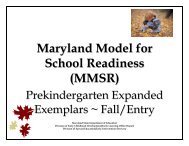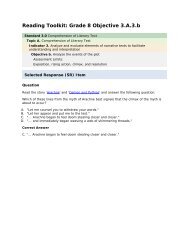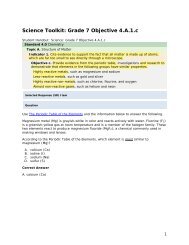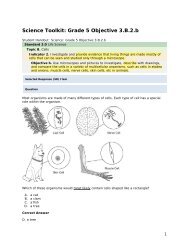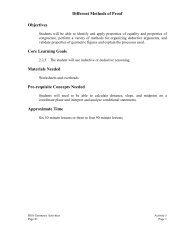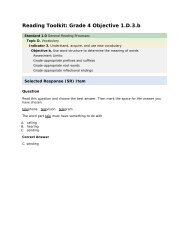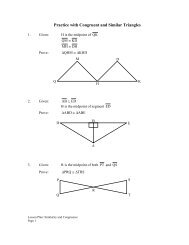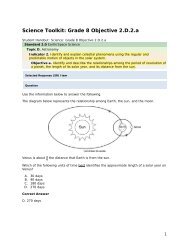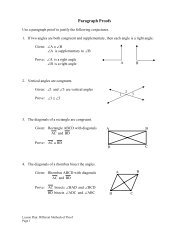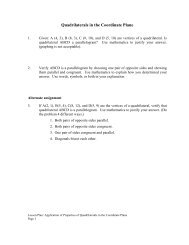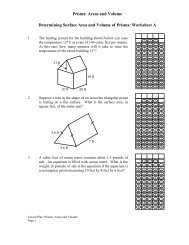Maryland common core state curriculum framework reading ... - mdk12
Maryland common core state curriculum framework reading ... - mdk12
Maryland common core state curriculum framework reading ... - mdk12
Create successful ePaper yourself
Turn your PDF publications into a flip-book with our unique Google optimized e-Paper software.
Reading Standards for Literature (RL)<br />
<strong>Maryland</strong> Common Core State Curriculum<br />
English Language Arts<br />
Cluster: Craft and Structure<br />
RL5 CCR Anchor Standard Analyze the structure of texts, including how specific sentences, paragraphs, and larger portions of the text (e.g., a section, chapter, scene, or stanza) relate to<br />
each other and the whole.<br />
Grade 9-10 students:<br />
RL5 Analyze how an author’s choices concerning how to structure a text, order events<br />
within it (e.g., parallel plots), and manipulate time (e.g., pacing, flashbacks) create such<br />
effects as mystery, tension, or surprise. (SC, 9-10)<br />
Essential Skills and Knowledge<br />
• Identify and explain the structural characteristics of complex narrative texts and use<br />
those characteristics when interpreting texts.<br />
• Analyze and explain how an author deliberately manipulates text structures, orders<br />
events, and the uses elements of time to create a specific effect and mood.<br />
• Participate actively and appropriately in discussions about literature.<br />
• Interpret, explain, and apply appropriate academic and/or domain-specific<br />
vocabulary when responding and discussing literature. (See 9-10 CCSS L.4 & L.6)<br />
• Use knowledge of language and its conventions when speaking and writing. (See 9-<br />
10 CCSS L.1)<br />
Grade 11-12 students:<br />
RL5 Analyze how an author’s choices concerning how to structure specific parts of a text (e.g., the<br />
choice of where to begin or end a story, the choice to provide a comedic or tragic resolution)<br />
contribute to its overall structure and meaning as well as its aesthetic impact. (SC, 11-12)<br />
Essential Skills and Knowledge<br />
• Explain, analyze, and evaluate the structural characteristics complex narrative texts and use<br />
those characteristics when interpreting texts.<br />
• Analyze and explain how an author’s deliberate manipulation of the internal structures of a<br />
text contributes to its overall structure, meaning, and effect.<br />
o<br />
Analyze the effect of an author’s:<br />
• decision on where to begin and/or end a story<br />
• choice of a comedic or tragic resolution<br />
• Participate actively and appropriately in discussions about literature.<br />
• Interpret, explain, and apply appropriate academic and/or domain-specific vocabulary when<br />
responding and discussing literature. (See 11-12 CCSS L.4 & L.6)<br />
• Use knowledge of language and its conventions when speaking and writing. (See 11-12<br />
CCSS L.1)<br />
RL6 CCR Anchor Standard Assess how point of view or purpose shapes the content and style of a text.<br />
Grade 9-10 students:<br />
Grade 11-12 students:<br />
RL6 Analyze a particular point of view or cultural experience reflected in a work of RL6 Analyze a case in which grasping point of view requires distinguishing what is directly <strong>state</strong>d<br />
literature from outside the United States, drawing on a wide <strong>reading</strong> of world literature. in a text from what is really meant (e.g., satire, sarcasm, irony, or under<strong>state</strong>ment).<br />
Essential Skills and Knowledge<br />
Essential Skills and Knowledge<br />
• Understand, appreciate, and make connections with different cultures and points of • Analyze and evaluate the appropriateness of a specific tone and/or shift in tone for a<br />
view.<br />
particular purpose, character, speaker, or situation.<br />
• Identify, analyze and explain the influence, effect, or impact of historical and/or • Analyze, and explain the implied meaning of the text.<br />
cultural experience on narrative text.<br />
• Distinguish among types of irony (e.g., verbal, situational, dramatic).<br />
• Analyze the significance and effect of the author’s point of view and biographical • Analyze and evaluate the overall effect of the use of irony and its impact on achieving the<br />
experiences on narrative text.<br />
author’s purpose.<br />
• Participate actively and appropriately in discussions about literature.<br />
• Analyze the characteristics of particular literary subgenres (e.g., satire, farce, sarcasm,<br />
• Interpret, explain, and apply appropriate academic and/or domain-specific<br />
under<strong>state</strong>ment, parody, allegory) as they create meaning and achieve the author’s purpose.<br />
vocabulary when responding and discussing literature. (See 9-10 CCSS L.4 & L.6) • Participate actively and appropriately in discussions about literature.<br />
• Use knowledge of language and its conventions when speaking and writing. (See 9- • Interpret, explain, and apply appropriate academic and/or domain-specific vocabulary when<br />
10 CCSS L.1)<br />
responding and discussing literature. (See 11-12 CCSS L.4 & L.6)<br />
• Use knowledge of language and its conventions when speaking and writing. (See CCSS L.1)<br />
MSDE.R/ELA.6/13/2011 3



